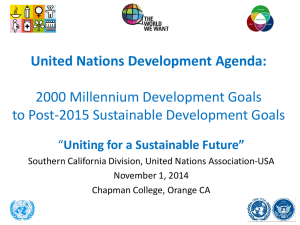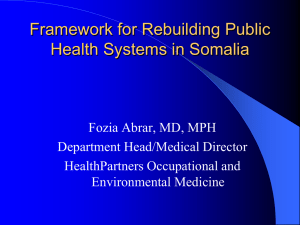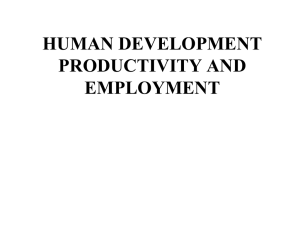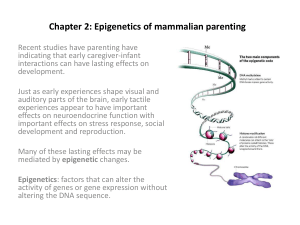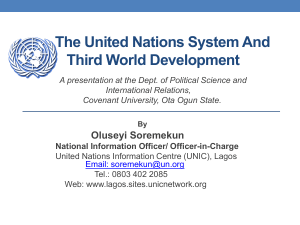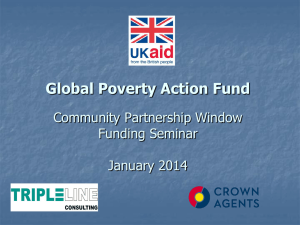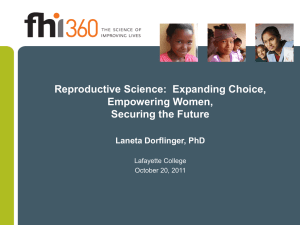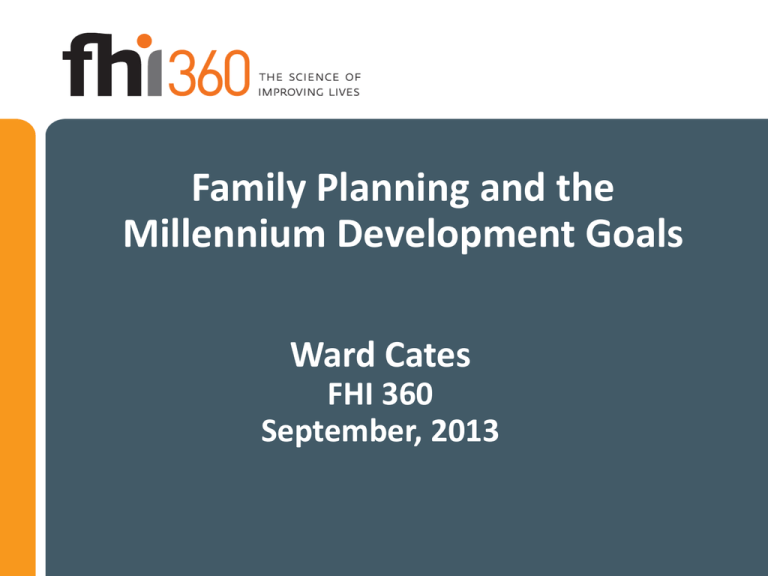
Family Planning and the
Millennium Development Goals
Ward Cates
FHI 360
September, 2013
Global FP Perceptions –
Findings from Gates Survey ‘09
• Global FP is not an end in itself
• FP is a broad range of RH services, not just
contraception
• FP is one of various means to improve health
and quality of life
• Providing evidence of FP impact on health and
development goals is crucial
Millennium Development Goals:
What Are They?
• 2000-2015 targets for development
• Commitments by 181 UN nations
• Priorities for global funders
• Opportunities for multinational
organizations
Millennium Development Goals
1.
2.
3.
4.
5.
6.
7.
8.
End Poverty and Hunger
Universal Education
Gender Equality
Child Health
Maternal Health
Combat HIV/AIDS
Environmental Sustainability
Global Partnerships
FP and MDGs
End Hunger
and Poverty
FP
FP Generates Wealth
• Per capita GNP associated with prevalence of modern
contraceptive methods
– South Korea
– Jamaica
– Mali
Modern
Methods
GNP
70%
58%
5%
9,700
1,510
250
• Women’s weekly income directly associated with lower
number of pregnancies
Source: FHI Women’s Studies Project, PRB Fact Sheet
GNI per capita
Children per woman
Smaller Family Size Contributed to
“Asian Miracle,” 1960-2005
Source: World Bank (2006)
FP Reduces Hunger
Million
Billion
Days
108
1200
3.7
62
980
3.1
775
2.6
N/P
Undernourished
1997
Total Population
2007
World Grain
Stocks
2017
Source: Brown (2009)
FP and MDGs
End Hunger
and Poverty
FP
Increase
Education
FP Prolongs Education
• Pregnancy a major obstacle to school
attendance
– High levels of pregnancy in youth
– < half African girls complete primary school
• Population growth puts pressure on limited
school infrastructure
FP and MDGs
End Hunger
and Poverty
FP
Increase
Education
Empower
Women
FP Empowers Women
• Women who use FP more likely to be employed than
non-users (Indonesia, Zimbabwe, Bolivia)
• Long-acting/permanent contraceptive methods
associated with greater likelihood of working for pay
(Brazil, Indonesia)
• Improves partner relations, family well-being, and
community involvement (Philippines)
• Unplanned pregnancies interrupt work and career
plans (Egypt)
Source: FHI Women’s Studies Project
Empowering Women
FP and MDGs
End Hunger
and Poverty
FP
Increase
Education
Empower
Women
Improve
Infant
Health
FP Saves Infants
• Spacing planned births and limiting
unintended births increases child survival
• Currently, 2.7 M infant deaths are averted
globally each year by preventing
unintended pregnancies
Source: DHS
Child Mortality by Birth Interval
Relative Risk Child Mortality
3.5
3
2.5
2
1.5
1
0.5
0
<18
18-23
24-29
30-35
36-41
42-47
48-53
54-59
60+
Birth Interval (Months)
Source: DHS; Rutstein (2005)
FP and MDGs
End Hunger
and Poverty
FP
Improve
Maternal
Health
Increase
Education
Empower
Women
Improve
Infant
Health
FP Improves Maternal Health
• Unintended pregnancies affect women’s
health
– Risks of terminating pregnancy – unsafe
abortion
– Risks of continuing pregnancy – maternal
mortality
• 70% of global maternal deaths could be
averted if FP needs met
FP Reduces Abortion
Relative Contraceptive and Abortion Prevalence
Russia (1988-1998)
200
178
Modern contraception
100
Abortion
47
0
1988 1989 1990 1991 1992 1993 1994 1995 1996 1997 1998
Source: Westoff (2005)
FP Reduces Maternal Mortality
Contraceptive
Prevalence*
Lifetime
probability of
maternal death
(1/X)
US
73%
2,500
South Africa
55%
120
Namibia
43%
54
Malawi
26%
7
COUNTRY
* Percent of married women ages 15-49 using modern method
Source: WHO (2004)
FP and MDGs
End Hunger
and Poverty
FP
Decrease
HIV/AIDS
Improve
Maternal
Health
Increase
Education
Empower
Women
Improve
Infant
Health
FP Prevents HIV
4 Phase Approach to Perinatal HIV Prevention
Prevention of
HIV in
women,
especially
young
women
Prevention of
unintended
pregnancies
in HIVinfected
women
Prevention of
transmission
from an HIVinfected
woman to her
infant
Phase 1
Phase 2
Phase 3
Support for
mother and
family
Phase 4
FP and MDGs
End Hunger
and Poverty
Save the
Environment
Decrease
HIV/AIDS
FP
Improve
Maternal
Health
Increase
Education
Empower
Women
Improve
Infant
Health
FP Protects the Environment
• Rapidly growing population exacerbates
environmental degradation
• Slower population growth places less stress
on limited natural resources, including fresh
water and arable land
• Preventing unintended pregnancy is the
factor in population growth most amenable
to intervention
Source: PRB, 2009
FP and MDGs
Support
Global
Partnerships
Save the
Environment
Decrease
HIV/AIDS
End Hunger
and Poverty
FP
Improve
Maternal
Health
Increase
Education
Empower
Women
Improve
Infant
Health
FP Promotes Partnerships
• Four decades of global investment in FP
programs has contributed strong
collaboration among:
– International agencies
– Governmental ministries
– Multinational organizations
– Local NGOs/community groups
FP and MDGs in Science
SRH and HIV: Key Linkages
SRH
• Family Planning
• Maternal & infant
care
• Management of
sexually
transmitted
infections
• Management of
other SRH
problems
Key
Linkages
Learn HIV status
Promote safer sex
Optimize connection
between HIV/AIDS
and STI services
HIV/AIDS
• Prevention
• Treatment
• Care
• Support
Integrate HIV/AIDS
with maternal and
infant health
Source: WHO/UNAIDS, IPPF/UNFPA (2005)
FP Integration in
Multiple Development Sectors
Beyond the MDGs
• Enhance National Security
• Defuse Explosive Societies
• Optimize Financial Resources
The New Population Bomb
Changing Demographic Composition and Distribution
• Shift in “demographic weight” from higher to
lower-resource countries
• Aging of higher-resource countries
• Youth bulge in lower-resource countries
• Urbanization of lower-resource countries
Source: Goldstone (2010)
FP Stabilizes Societies
“High birth rates...produced a common
problem ― a large, steadily increasing
population of young men without any
reasonable expectation of suitable or
steady employment ― a sure
prescription for social turbulence.”
Source: The 9/11 Commission Report (2004)
Proportion of Youth Aged
<25, by Region
0-14
15-24
100
75
50
25
0
Africa
Latin East Asia South
America
Asia
Middle
North Europe
East America
Source: UN (2007)
The “Youth Bulge” Impact
• Disproportionate levels of young adults
associated with political volatility and
violence
• Countries with youthful age structure slow to
become stable democracies ─ Middle East,
Africa
• Democratic countries with high proportion of
youth are less stable ─ Latin/South America
Source: Cincotta (2009)
FP Saves Dollars
• Preventing unintended pregnancies is less
expensive than treating maternal/ infant
complications of pregnancy
• Longer acting contraceptive methods are the
most cost-effective
• Up to $31 can be saved for every dollar spent
on FP (UNFPA)
Family Planning and MDGs:
Cost Savings in Zambia
120
Total Savings: $111 M
Malaria $4 M
100
80
60
40
20
Maternal Health
$37 M
Water Sanitation
$17 M
Immunization
$17 M
Education
$37 M
Total Costs: $27 M
Family Planning
$27 M
0
Source: USAID-Zambia (2008)
FP and MDGs
Support
Global
Partnerships
Save the
Environment
Decrease
HIV/AIDS
End Hunger
and Poverty
FP
Improve
Maternal
Health
Increase
Education
Empower
Women
Improve
Infant
Health
• FP affects all 8 MDGs
• FP is one of multiple interventions to improve health and development
Conclusion
• Investing in global FP programs will help
achieve all 8 MDGs
• Strengthening global FP programs contributes
to integrated, multisectoral development
• Investing in global FP programs will optimize
financial resources

